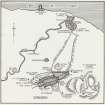Following the launch of trove.scot in February 2025 we are now planning the retiral of some of our webservices. Canmore will be switched off on 24th June 2025. Information about the closure can be found on the HES website: Retiral of HES web services | Historic Environment Scotland
Edinburgh, St Leonard's Chapel And Hospital
Chapel (Medieval), Hospital (Medieval)
Site Name Edinburgh, St Leonard's Chapel And Hospital
Classification Chapel (Medieval), Hospital (Medieval)
Canmore ID 52540
Site Number NT27SE 74
NGR NT 2651 7290
Datum OSGB36 - NGR
Permalink http://canmore.org.uk/site/52540
- Council Edinburgh, City Of
- Parish Edinburgh (Edinburgh, City Of)
- Former Region Lothian
- Former District City Of Edinburgh
- Former County Midlothian
NT27SE 74 2651 7290.
(Name: NT 2654 7290) Chapel & Hospital (NR) (site of)
OS 1:1250 plan, (1971)
The Hospital and Chapel of St Leonard formerly stood on the high ground now occupied by the James Clark Technical School. The arrangement of the buildings is unknown, but the hospital appears to have lain to the S of the chapel. Both chapel and hospital belonged to Holyrood Abbey, and it is probable that they took the place of an earlier hermitage (RCAHMS 1951). They were in existence before 1261, and restored and reconstituted in 1493. The chapel is again noted in 1528 and 1650, but how or when its function ended is not know. The chapel walls, then 4' high, were destroyed in 1854, when many skeletons were found both inside and outside the chapel precincts.
RCAHMS 1951; D E Easson 1957.
The James Clark Technical School, on the site of St Leonard's Hospital and Chapel, is centred on NT 2652 7293. No further information.
Visited by OS (J L D) 31 December 1953.
Publication Account (1951)
165. Hospital of St. Leonard, St. Leonard's Hill.
The Hospital and Chapel of St. Leonard formerly stood on the high ground now occupied by the James Clark Technical School. The arrangement of the buildings is unknown, but the Hospital appears to have lain to the S. of the Chapel (1). Both Chapel and Hospital belonged to Holyrood Abbey, and it is probable that they took the place of an earlier hermitage (2), which would have been conveniently placed here for sheltering travellers arriving from the south after the closing of the town gates. The Hospital and Chapel were in existence in 1271, at which date the Serving Brothers of the Hospital were in litigation with the Rector of Hailes (3). In 1334 a chaplain was appointed by Edward 111 (4); and after the expulsion of the English the Chapel and Hospital seem to have passed into the possession of Edinburgh, as in 1390 the Abbey obtained from Robert III a charter affirming that both belonged to the Abbot and Canons of Holyrood (5). Neither the Liber Cartarum Sancte Crucis nor the Chronicon of Holyrood contains any mention of the foundation until 1493, when Abbot Bellenden granted a new charter (6) providing for the restoration of the buildings, which were evidently ruinous, and for the endowment of the Hospital with the means of maintaining six old men. Both before and after this date the chaplain had as his manse a house standing immediately N. of the great gate of the Abbey (7). The Chapel comes into notice again in 1528, when it was the scene of a meeting of the Douglases, in conspiracy to murder James V (8); and once more in 1650, when Colonel Lawers occupied the hill in the course of the fighting against Cromwell (9). How or when the career of the foundation ended is not known; its site may be that shown by a mark which appears on a map drawn about 1730 (10), and the remains of the Chapel walls, then 4 ft. high, were destroyed in 1854 (11). During the demolition many skeletons were found both inside and outside the Chapel precincts; but the bodies found outside the Chapel are quite unlikely to have been those of malefactors hanged on the gibbet of East Burgh Muir, as Forrest supposed, seeing that the gibbet stood at the head of the modern East Preston Street, at a considerable distance from this site.
RCAHMS 1951
(1) Forrest, An Account of the History and Antiquities of St. Leonard's, Edinburgh, its Chapel and Hospital, p. 31. (2) The names of two crofts belonging to the Hospital, "Hermits" and "Terrars," or "Termits," which occupied part of the site of the railway coal-depot of St. Leonard's, may well represent the words "terras eremiti" occurring in some lost charter. (3) Registrum de Dunfermelyn, p. 137. (4) Calendar of Documents relating to Scotland, iii, No. 1130. (5) Calendar of the Papal Registers, xii, p. 734. (6) Reg. Mag. Sig., 1424-1513, No. 2192. (7) Ibid. (8) Acts Pari. Scot., ii, pp. 362, 364. (9) Balfour, Annales of Scotland, iv, pp. 87 f. (10) "The Early Views and Maps of Edinburgh," in Scottish Geographical Magazine, xxxv, Old Edinburgh Maps No. 2. 11 Forrest, op. cit., pp. 24 ff.










